Soil Management: Soil and Water Conservation Management
[addw2p name=”soilMgmtGeneral”]
Erosion and run-f commences with the dispersions or breakdown of soil particles in topsoil from the impact of rain. The dispersed soil particles and the usually more compact sub-soil slow down infiltration of the rain water into the soil. This accelerates and increases run-off which occurs when rate of rainfall exceeds infiltration rate of water into the soil. Loss of topsoil not only reduces soil fertility but also means lower water-holding capacity of the soil.
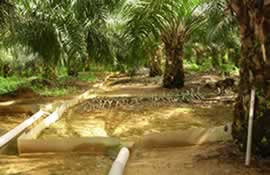
Erosion plots

AAR – Felda agronomists beside leaching column
In Malaysia, soil erosion under oil palms on slopes of 4 to 7 was measured at 6 to 13 t ha-1 yr-1 (Maene et al ., 1979; Lim, 1990) compared to jungle area at 0.31 t ha-1 yr-1 (Maene and Sulaiman, 1980). Factors which affect the rate of soil loss are rainfall, rate of run-off, soil types, slope, plant cover and presence or absence of conservation measures.
The main objectives of soil and water conservation are to obtain the maximum sustained level of production from a given area of land by preventing soil degradation and environmental pollution. Therefore, soil conservation practices usually aim at the primary causal factors and areas. For example, reducing or protecting bare areas or exposed soil and reducing the rate of run-off. Timing in implementation of soil conservation measures is also important in plantation tree crops, as the highest risk of erosion usually occurs in specific period such as during planting or replanting and monsoon season.
Soil conservation practices should be considered in the following situations also :
- strongly sloping or rolling areas and steeper (8 or more), particularly where slopes are long,
- highly erodable soils especially in areas with slopes about 6o. Such soils are usually sandy, with weak structure and low in organic matter such as Malau series and Kapilit Family soils,
- areas with poor crop canopies and bare soil or sparse ground cover conditions,
- areas with high and frequent intense rainfalls of more than 25 mm hr-1,
- shallow soils (less than 50 cm) and compacted soils areas.
Lim et al . (1994) suggested that soil and water conservation measures should be implemented on slopes of 30 or more but this has not been adopted by most plantation companies.
The following soil conservation practices should be considered for application in appropriate situations, depending on the specific erosion risks posed in the areas.
Terracing
Generally, there are two kind of terraces, that is, planting terraces and conservation terraces. The former is constructed mainly to facilitate harvesting, crop evacuation and maintenance operation apart from conserving soil and water. Planting terraces should slope inwards and there should be a vertical drop of about 50 cm between the lip and the rear of the terrace to trap run-off water. Regular stops along the terraces are also necessary for the same purpose.
The dimensions of terraces depend on the crops, planting density, slopes and whether future mechanisation will be implemented. In general, the terraces for oil palms should be more than three metre wide and the horizontal distance between two adjoining terraces (6.5 to 9.5 metres) will depend on the planting distance along the terrace and planting density. Similarly for rubber except that the terrace width is generally smaller at 2 metres or more. For cocoa, planting terraces are seldom constructed although it is now highly recommended. The terraces should be 2.5 to 3.5 metre wide with about 12 metres horizontal distance between two adjoining terraces. There is one terrace in every 3rd cocoa row; the other cocoa trees are planted on platforms.
Long slopes which are less than 8 or short rolling to hilly slopes may require conservation terraces instead. They should be cut at approximately 30m intervals, primarily to reduce the length of slope. If platforms are made, they should be about 1.5m x 1.5m for oil palms and 1m x 1m for cocoa.
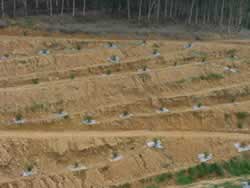
Terracing
Establishment of leguminous cover crops
In cocoa, it is generally not a recommended practice to establish leguminous cover crop. The creeping habit of legumes and high stand of cocoa will make it difficult to maintain. However, other desirable ground vegetation should be kept as discussed in the next section.
In oil palms and cocoa, it is important to establish the legumes to reach full ground coverage as rapidly as possible after land preparation where threats of erosion and land degradation are most real. Ling et al (1979) showed that soil loss on a 10 gradient Munchong series can be 8 folds higher on bare soil compared to legumes or natural covers (Table 3). This is even more important where the effective soil depth is already shallow. Furthermore, Ling et al (1979) reported that soil loss was reduced from 9.0 t ha-1 yr-1 at 0-30% ground coverage to 0.1 t ha-1 yr-1 at 90-100% ground coverage (Table 4). Similar marked reduction in run-off losses were also obtained. Moreover, the other beneficial effects of legumes on soil fertility, soil physical properties and soil biological activities are well-known.
|
Vegetation |
Rainfall (mm) |
Run-off (mm) |
Run-off (% rainfall) |
Soil loss (t ha-1 yr-1) |
|
Bare soil |
1854 |
236 |
15 |
79 |
|
Legumes |
1854 |
70 |
5 |
11 |
|
Natural cover |
1854 |
61 |
3 |
10 |
|
Vegetation |
Ground cover |
|||||
|
0 – 30 % |
90 – 100 % |
|||||
|
Rainfall (mm) |
Run-off (mm) |
Soil loss (t ha-1 yr-1) |
Rainfall (mm) |
Run-off(mm) |
Soil loss (t ha-1 yr-1) |
|
|
Bare soil |
269 |
57 |
13.5 |
287 |
64 |
11.3 |
|
Legumes |
269 |
47 |
9.0 |
287 |
3 |
0.1 |
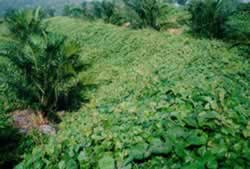
Good legume covers
Maintaining ground vegetation
Table 3 shows that natural covers which are not competitive for nutrients and water can be used to reduce soil erosion and run-off losses. This will improve soil moisture balance compared to bare soil conditions.
Good maintenance of ground covers is especially important in cocoa where legume covers are not established. In the other tree crops, they should be encouraged to gradually succeed the legumes as the latter dieback due to shading effect.
 Good Ground Cover – Nephrolepis |
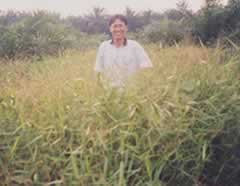 Poor ground cover – thick grasses |
Frond stacking
In mature oil palms there is an additional opportunity to correctly stack the pruned fronds across the slope and cover as much ground area as possible to help in reducing the run-off and erosion losses substantially. This was demonstrated by Maene et al . (1979) on Durian series with mature oil palms on 5 to 9% slopes (Table 5). In terraced areas, pruned fronds placed across the terrace width at regular intervals will also assist to break the flow of run-off water.
| Position in field |
Nutrient loss as % of fertilizer nutrients added |
|||||
|
N |
P |
K |
Mg |
Ca |
B |
|
| Oil palm row |
13.3 |
3.5 |
6.0 |
7.5 |
6.8 |
22.9 |
| Harvest path |
15.6 |
3.4 |
7.3 |
4.5 |
6.2 |
33.8 |
| Pruned frond row |
2.0 |
0.6 |
0.8 |
2.7 |
0.8 |
3.3 |
| Pruned frond/harvest path |
6.6 |
1.4 |
3.5 |
2.2 |
3.4 |
12.5 |
| Average for the field |
11.1 |
2.8 |
5.0 |
5.6 |
5.2 |
20.7 |
| Nutrient from fertiliser applied (kg ha-1) |
90.2 |
52.0 |
205.9 |
32.8 |
78.9 |
2.4 |
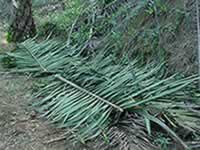
Frond stacking
Mulching with empty fruit bunches (EFB)
Wherever EFB is available, it can be suitably used for mulching especially in new plantings. The mulch will :
- minimise erosion and run-off losses of the bare soil,
- reduce soil moisture evaporation loss during the dry months (Lim and Messchalch, 1979),
- supply nutrients to the planted seedlings,
- improve soil conditions.
Fresh EFB can contain high soluble salts and it is best to keep the EFB until part of the soluble salts are washed or leached off by rain before application to cocoa, which is sensitive to high conductivity.

EFB mulching
Silt pits
In some areas, soil erosion and run-off may be very severe even with the construction of soil conservation and planting terraces. For such special areas, the digging of silt pits may be helpful as shown by Lim et al . (1994). However, yield response to silt pitting has not been established.

Silt pit
